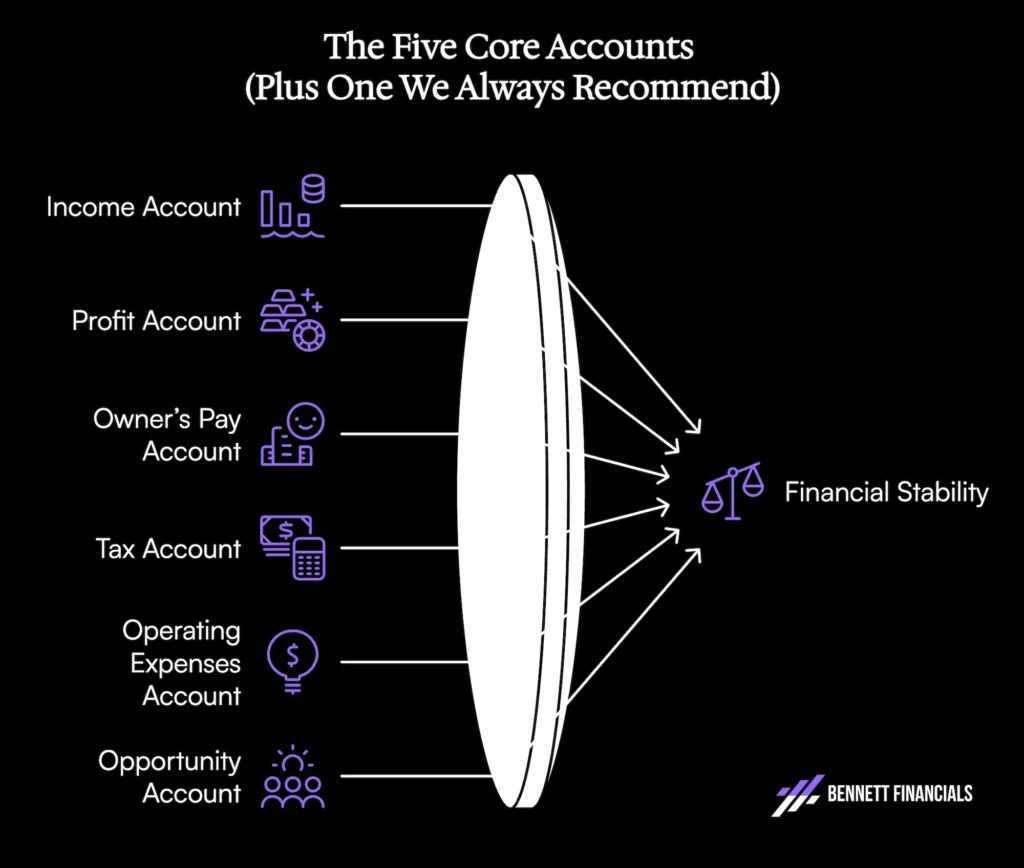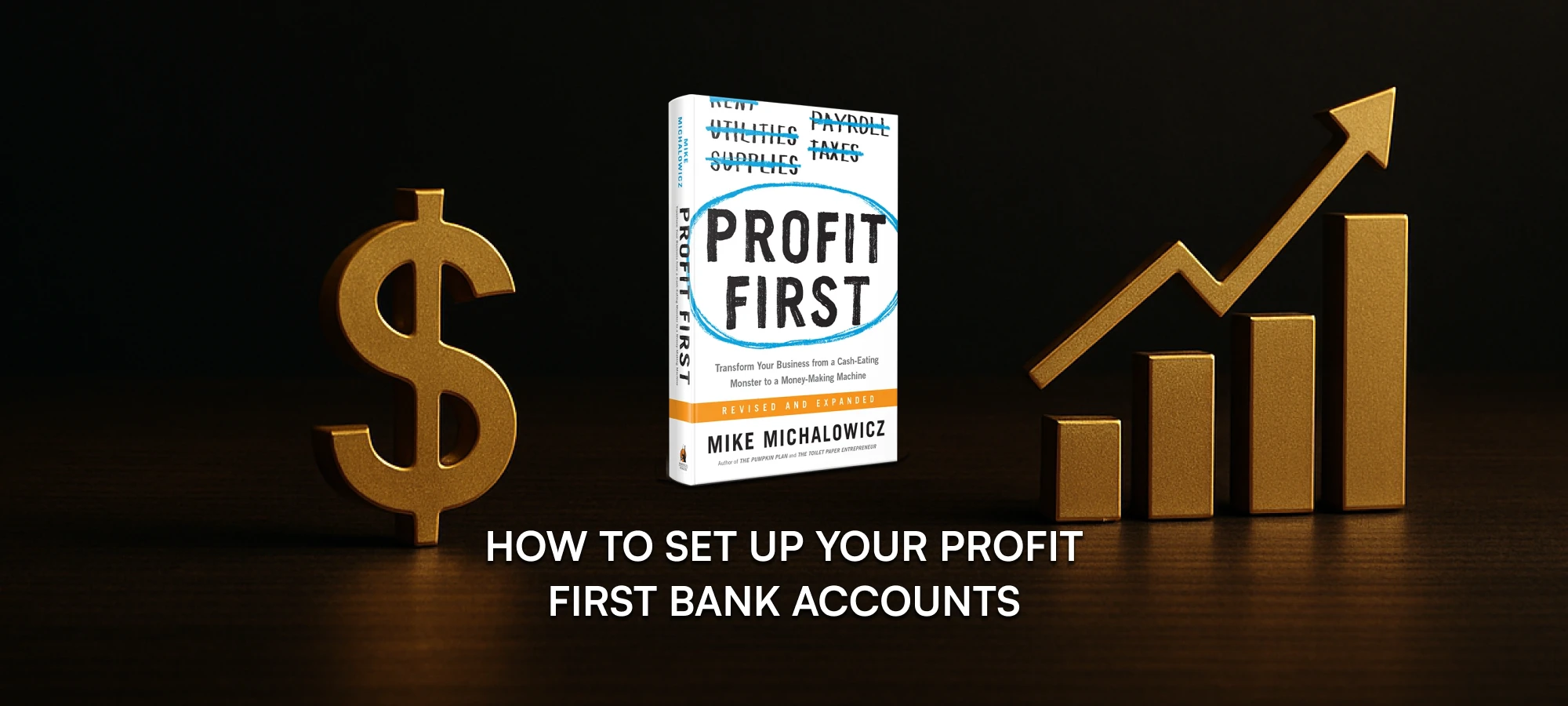The most common thing we hear from business owners when we introduce Profit First is this:
“I love the idea. I just haven’t gotten around to setting it up yet.”
The hesitation isn’t because they don’t believe in the system. It’s because they’re afraid of doing it wrong or making their financial life more complicated than it already feels.
This chapter is here to remove that fear. Because once you understand the goal isn’t perfection it’s clarity you’ll realize just how easy this is to get moving.
Don’t Overthink It. Just Get the Buckets in Place.
Profit First works because of separation and visibility. That starts with opening bank accounts that each serve a specific purpose.
You’re not building a fortress. You’re building five (or six) buckets so money doesn’t all sit in one big puddle where it gets spent without intention.
Here’s what to do:
The Five Core Accounts (Plus One We Always Recommend)

- Income Account
This is where all revenue lands. It’s a temporary holding tank not a spending account. Remember, the Income account is purely a pass-through. All expenses, no matter how small, should be paid from the Operating Expenses account. You’ll make allocation transfers from here, usually twice a month. - Profit Account
This is your reward for owning the business. It’s where you build real margin. You’ll distribute this quarterly (we’ll cover that in a later chapter). Crucially, this account is for accumulating profit and future distribution it is not to be used for covering operating expenses. - Owner’s Pay Account
This is how you consistently pay yourself. It’s not leftovers it’s a fixed percentage of revenue that comes first. - Tax Account
This is where you set aside money for the IRS. If you’ve ever been blindsided by a tax bill, this account changes everything. - Operating Expenses Account (OPEX)
This is what you run the business on. Once the other accounts are funded, this is what’s left. If it’s tight, that’s a signal not a failure. The system is working. - Opportunity Account (Optional but critical)
We recommend this to every service-based entrepreneur. It’s your growth reserve. You can use it to self-fund a hire, a marketing push, a slow season, or to pounce on a business opportunity.
This account turns “maybe later” into “I’m ready now.”
Where to Open the Accounts
The best setup is this:
- Open the Income, Profit, Owner’s Pay, and Tax accounts at your main bank.
- Open the Profit and Opportunity Accounts at a second bank you don’t check often ideally with no debit card.
Why? Because you’re building friction. You want it to be a little annoying to dip into your profit. That delay protects your discipline.
This isn’t about hiding from your money it’s about respecting your priorities.
Pro tip: Relay is the official Profit First bank. It allows you to create and label all your accounts easily, automate transfers based on your allocation percentages, and set up rules so your business runs on autopilot. It’s designed specifically for this system, and for many of our clients, it makes implementation fast, seamless, and scalable.
Naming the Accounts
Use clear, obvious names. Don’t get clever. You want to feel what the money is for the second you see it.
If your bank doesn’t let you rename accounts, use nicknames in your online dashboard or add a one-letter prefix like:
- “P – Profit”
- “T – Tax”
- “O – OPEX”
- “OPP – Opportunity”
The point is to give every dollar a job and every job a label.
Your Transfer Rhythm
Twice a month is ideal. Most of our clients pick the 10th and 25th. Why?
- It avoids end-of-month chaos.
- It aligns with common billing cycles.
- It builds discipline through rhythm, not reaction.
This regular cadence keeps your financial visibility sharp, prevents cash from piling up unallocated, and turns allocation into a healthy habit that aligns with the natural revenue and expense cycles of your business rather than being a reactive scramble when bills are due.
On those days, you log into your Income account and move money into each of the other accounts based on your set percentages. Then you run the business out of OPEX.
It takes 15 minutes. But it gives you financial clarity for the next two weeks.
“What If I Don’t Have Enough to Fund Every Account?”
Start small. Even if you’re only putting 1% into Profit, do it. The act of allocating even in tiny amounts rewires how you see money.
If things are tight, keep your allocations small across the board. The goal isn’t to stretch yourself thin it’s to build consistency. We’ll revisit percentages later. For now, just get the system running.
Consistency is what builds clarity. Clarity is what builds control.
What to Expect in the First 30 Days
Most business owners feel a mix of excitement and mild panic when they start. That’s normal.
At first, your OPEX account will feel smaller than you’re used to. That’s the point. That discomfort is where the insights live. It shows you whether your current cost structure is actually sustainable or whether you’ve been covering up problems with volume.
Stick with it. You’ll adjust. And the moment you realize your tax bill is already funded? You’ll never go back.
Your First Step
Call your bank. Open the five core accounts (Income, Profit, Owner’s Pay, Tax, OPEX).
If you can, open a sixth Opportunity Account at a second bank.
Give them clear names. Set calendar reminders for two allocation days per month. And make your first transfer even if it’s just a few dollars.
You’ve just started managing your business based on intention, not anxiety.
Next, we’ll cover how much to actually allocate to each account and how to avoid common mistakes when you set your percentages.
Ready to Put Profit First?
Looking to set up your Profit First bank accounts for consistent profitability and crystal-clear financial understanding? Connect with the Profit First Professionals and we’ll get you set up right.
In the next chapter you’ll learn how to start allocating based on clear target percentages tied to your revenue.
This was a chapter form the upcoming ebook Profit First, Unofficial: A CFO’s Playbook for Owners.
Read the previous chapter, How Service Businesses Can Lock In Healthy Cash Flow with the Profit First Method.


